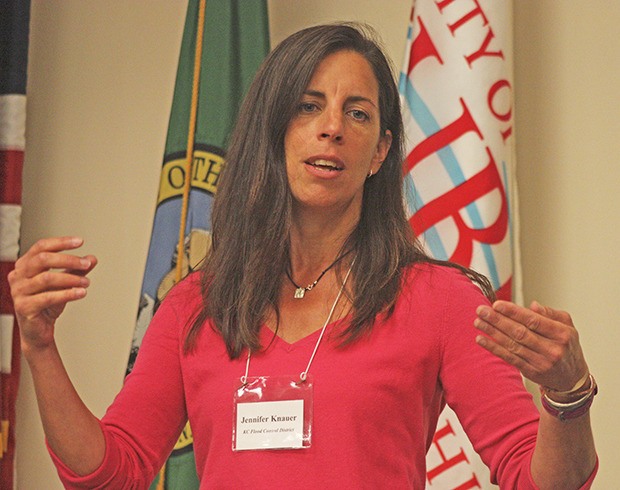Jennifer Knauer’s message at the public meeting at Auburn City Hall was simple, direct and effective – the Green River’s levee and revetment system is old, and the time to do what must be done to fix it is now.
Knauer and her King County Flood Control District colleagues came to Auburn Tuesday morning to energize and learn from the public, especially homeowners and entrepreneurs who live and work along the lower Green River, with its 16-plus miles of mostly aging levees. They wanted to hear their concerns and ideas at a time when the district is working on a longterm solution.
Indeed, a plan, the district’s Green River System-Wide Improvement Framework (SWIF) program, is already rolling. It is a multi-agency, two-year effort intended to produce prioritized flood protection projects and actions. The U.S. Army Corps of Engineers is working with the district on the planning process.
As Knauer, the SWIF project manager, explained, the plan is complicated, ambitious and absolutely crucial for protecting the interests of many people and their livelihoods. Auburn, Kent, Tukwila and Renton are among the cities directly affected.
And as the plan picks up speed, Knauer said, more people need to climb aboard.
“We are working hard among many agencies to make sure we are planning for both future development and protecting the environment … and making sure that our businesses, homes, lives and property are protected,” said Reagan Dunn, King County councilmember and chair of the flood district’s board of supervisors.
Dunn’s concerns are many.
The aging levee system – composed mostly of levees and revetments built by farmers in the 1960s – was built to protect sparsely populated agricultural lands, rather than the present landscape of residential development and significant regional economic infrastructure.
The likelihood of a widespread, damaging flood in the Green River Valley threatens an area that supports more than 100,000 jobs and generates billions of dollars in business.
To date, the Corps of Engineers has strengthened sections of the Green River levees in Auburn and Kent. The recently completed Reddington Levee Setback Project is among the success stories, Knauer said.
City officials now look to help Fenster Nature Park. Volunteers are needed to plant and mulch approximately 8,000 native plants at the park along the Green River – part of a larger levee setback project just completed in cooperation with the City and King County. The Oct. 11 planting project should improve salmon habitat and provide flood protection from the river.
In Kent, crews are busy repairing the district-funded, 2.7-mile Briscoe-Desimone levee project, which protects portions of Kent, Tukwila and Renton from flooding.
In 2009, crews repaired the Horseshoe Bend levee on the south end of Kent near South 262nd Street and Central Avenue, upgrading it to Federal Emergency Management Agency (FEMA) standards. The levee helps protect a stretch of the valley that extends all the way to Interstate 405 in Renton.
Still, other levees remain weak, district officials said.
“Our concerns from Auburn’s perspective are not nearly as severe as (downstream to) Kent and Renton,” said Auburn City Councilmember Wayne Osborne, who serves on the SWIF program advisory board. “However, one of our concerns is the back flow of Mill Creek and other areas … and what would be the situation in that case.”
Osborne, whose home is about 300 feet from the river, said it is important to get the word out to the public and help the district develop solutions to resolve long-standing flood protection problems.
In essence, the district needs a suitable plan and a common vision. The plan would take into account many factors, such as environmental, ecological, economic and social impacts.
“A lot of these levees are very, very old, and they need to be repaired, and they need to be looked at,” Osborne said. “What we are trying to do is what would be the best level of protection for the communities from Auburn downstream. That’s basically what they’re looking at because it’s completely changed – the property, the value and the economic benefits.”
The board is in the process of determining alternatives for aligning the new and improved levee system, specifically in terms of the size, scope and nature of setback areas, and the river’s interaction with shorelines.
The district is funding the project with a $300,000 grant from the state of Washington through Puget Sound Partnership. The district aims to finance the improvements while it seeks other revenue partners. Many agencies and industries have joined the effort.
For more information about the SWIF program, or to provide comments, visit www.kingcounty.gov/rivers or contact Jennifer Knauer at 206-477-4856 or Jennifer.knauer@kingcounty.gov.
=====
Public meeting
Join representatives of the King County Flood Control District for a presentation about the flood protection solutions being considered.
The meeting is 4 to 7 p.m. Tuesday, at the Kent Courthouse Rotunda, 401 Fourth Ave. N.
Project staff will be on hand to answer questions and solicit feedback.
Speakers include King County Flood Control District Chair Reagan Dunn and King County Flood Control District Supervisor Pete Von Reichbauer.
Please plan to arrive early at the Kent Courthouse, as you will need to go through building security screening. The entrance is on the west side of the building.


